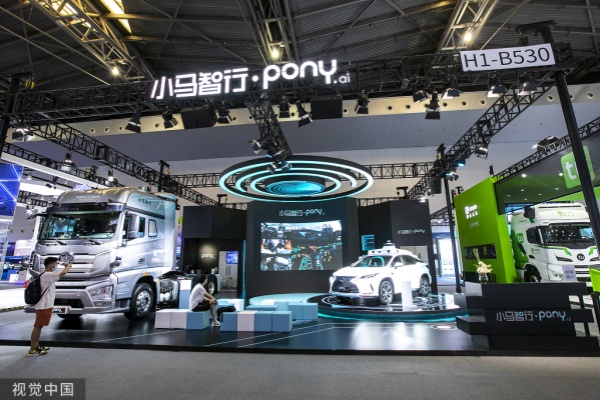
- Home
- Media Center
-
Events
- Wuzhen Summit
- Regional Forums
- Practice Cases of Jointly Building a Community with a Shared Future in Cyberspace
- World Internet Conference Awards for Pioneering Science and Technology
- The Light of Internet Expo
- Straight to Wuzhen Competition
- Global Youth Leadership Program
- WIC Distinguished Contribution Award
- Membership
- Research & Cooperation
- Digital Academy
-
Reports
- Collection of cases on Jointly Building a Community with a Shared Future in Cyberspace
- Collection of Shortlisted Achievements of World Internet Conference Awards for Pioneering Science and Technology
- Reports on Artificial Intelligence
- Reports on Cross—Border E—Commerce
- Reports on Data
- Outcomes of Think Tank Cooperation Program
- Series on Sovereignty in Cyberspace Theory and Practice
- Other Achievements
- About WIC
- 中文 | EN

Pony.ai does a giddyap in driverless biz

Driverless cars of Pony.ai are displayed at an expo in Shanghai on July 10, 2021. [Photo/VCG]
Chinese self-driving startup Pony.ai is accelerating steps to bolster the mass production and deployment of its Level 4 autonomous driving vehicles as part of its broader push to realize the commercial application of the self-driving technology in more cities.
Peng Jun, co-founder and CEO of Pony.ai, said China is expected to become the world's largest autonomous driving mobility services market in the next five to 10 years, adding that currently the company's Level 4 driverless tech has been able to realize large-scale commercial operations.
Currently, autonomous driving is categorized from Level 0 to Level 5. The higher the level, the more advanced and intelligent the technology. L4 autonomy means vehicles can drive themselves in most conditions without a human backup driver.
Peng said the company has cooperated with Sino-Japanese joint venture GAC Toyota to build new-generation self-driving driving vehicles, and advance the mass production and large-scale use of driverless robotaxis. It has also launched a robotaxi fleet with Ontime, a Chinese mobile transportation services provider.
Earlier this month, Pony.ai received permits to operate fully driverless robotaxis, in which no safety supervisors are present, along a 205-kilometer route in Shanghai's Pudong New Area. Individuals can now book driverless robotaxis in designated areas in Shanghai via its mobile app.
Prior to receiving this approval, the company had already obtained licenses for fully driverless robotaxi services in Beijing, and Guangdong province's Guangzhou and Shenzhen.
Pony.ai announced it had launched the paid robotaxi services at Beijing Daxing International Airport in June, and has been among the first batch of companies in Beijing allowed to carry out trial commercial operation of autonomous driving vehicles on expressways.
The permits come with the precondition that a safety inspector will sit behind the steering wheel and take manual control in case of an emergency. The move signifies the inaugural launch of paid autonomous driving services at a major transportation hub in Beijing.
Peng said autonomous driving will become a pivotal part of smart transportation and drive the construction of smart cities, with far-reaching impacts, such as improving the overall economy and changing the way people travel.
The company has also been making forays into the self-driving truck segment, hoping to test self-driving trucks on more expressways to provide safer and more effective solutions and improve logistics efficiency.
Yang Diange, a professor at Tsinghua University's School of Vehicle and Mobility, said, "L4 self-driving technology will first be deployed in taxis, trucks and some designated areas, and large-scale application of such technology in private vehicles might be seen by 2030."
Commercial operation of self-driving vehicles will promote the iteration and innovation of technologies, and help enterprises explore viable business models, thus allowing autonomous driving technologies to create more value, Yang said.
In recent years, China has introduced a series of policies to promote the development and commercial use of self-driving technology.
The Ministry of Industry and Information Technology as well as four other central government departments selected 20 cities — including Beijing, Shanghai and Chongqing — earlier this month to participate in a pilot program of "vehicle-road-cloud integration" for intelligently connected vehicles.
More than 50 cities nationwide have released autonomous driving pilot demonstration policies, and stepped up efforts to expand the application scenarios of self-driving technology.
Zhang Xiang, an auto sector researcher at North China University of Technology, said production costs of driverless vehicle components, such as lidar sensor systems, have declined along with advances in self-driving technology and maturation of related industrial chains.
He said more efforts are needed to accelerate the building of an intelligent transportation system, including the 5G-enabled vehicle-to-everything technology, which allows a vehicle to share real-time information with other vehicles, pedestrians and roadway infrastructure such as traffic lights to improve efficiency.

The World Internet Conference (WIC) was established as an international organization on July 12, 2022, headquartered in Beijing, China. It was jointly initiated by Global System for Mobile Communication Association (GSMA), National Computer Network Emergency Response Technical Team/Coordination Center of China (CNCERT), China Internet Network Information Center (CNNIC), Alibaba Group, Tencent, and Zhijiang Lab.





